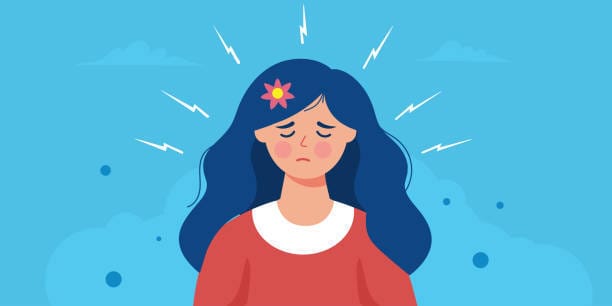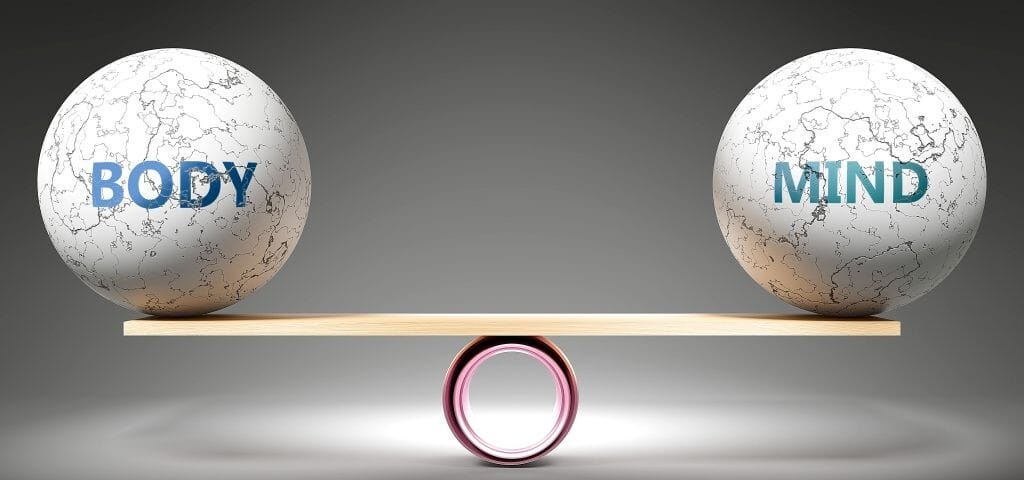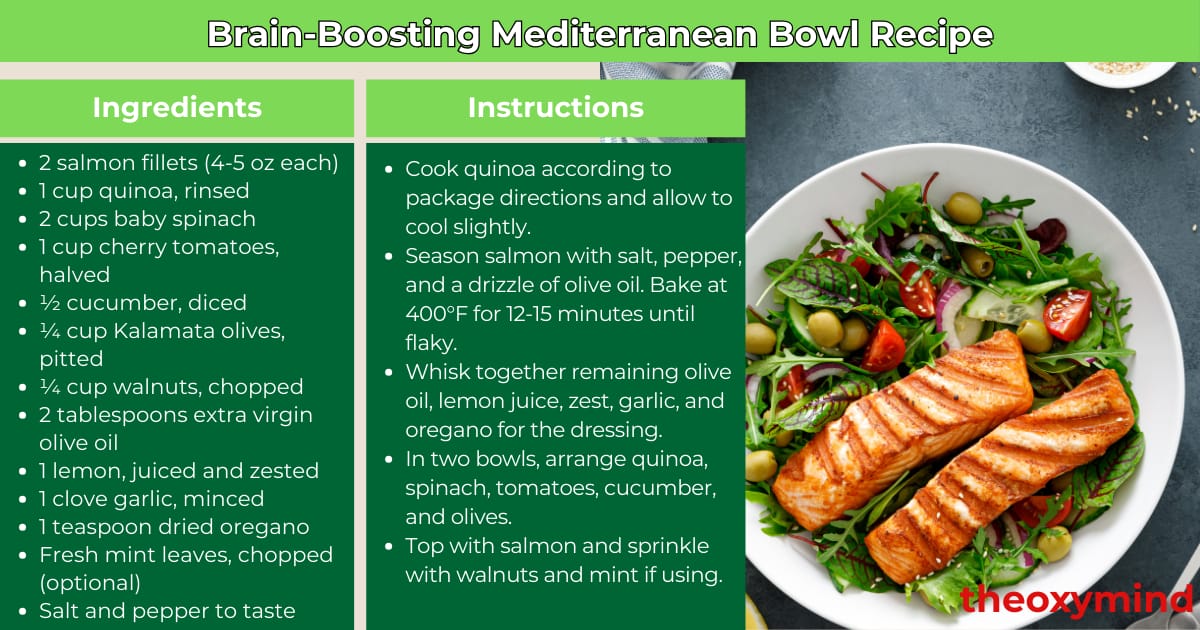- The Oxymind
- Posts
- Unleash the Power of the Mind: Harness Your Inner Potential
Unleash the Power of the Mind: Harness Your Inner Potential
Transform Thoughts Into Action, Doubt Into Drive, and Vision Into Reality.
In Today’s Edition
Unlocking the Power of the Mind
Recipe of the week: Brain-Boosting Mediterranean Bowl
Resource of the Week
The Productivity Hack: The "Mental Contrasting" Method
Welcome to this week edition of The OxyMind! Today, we're exploring one of the most fascinating frontiers of human potential: the remarkable power of our minds. As we navigate our increasingly complex world, understanding how to harness our mental capabilities has never been more important.
It starts with the right brain's biology—think of it as the hardware. You can pour all your energy into mental health, the software, but if the brain’s not wired right, it’s like running a fancy app on a broken phone. It just won’t work well. That's why so far we've focused on the right fuels for the brain. Sleep, Nutrition, and Movement impact our brain as much as our body.
"The mind is everything. What you think you become."
In this issue, we'll dive into the science of neuroplasticity, explore practical mindfulness techniques, examine how visualization shapes our reality, and discover the profound mind-body connection. My hope is that you'll finish reading with not just knowledge, but practical tools to unlock more of your mind's potential.

The Science of Neuroplasticity: Your Brain is a Work in Progress
For decades, scientists believed the adult brain was fixed and unchangeable. Today, we know better: our brains continuously reorganize themselves throughout our lives—forming new neural connections and pathways in response to our experiences, thoughts, and actions.
This remarkable capacity, known as neuroplasticity, means your brain is literally shaped by how you use it. Learning a new skill, changing a habit, or adopting a different perspective all create physical changes in your brain structure.
What this means for you:
The "use it or lose it" principle is real—mental exercises strengthen neural connections much like physical exercise strengthens muscles
Recovery from brain injuries is possible as the brain can reroute functions through undamaged pathways
Negative thought patterns create "neural superhighways" that become easier to travel, but can be redirected with conscious effort
Dr. Lara Shepherd, neuroscientist at Pacific University, explains: "The discovery of neuroplasticity is perhaps the most important breakthrough in our understanding of the brain in the last century. It gives us scientific proof that we can be active participants in our brain development throughout our entire lives."
Mindfulness: The Art of Paying Attention
In our distraction-filled world, the ability to direct and sustain attention is increasingly rare—and increasingly valuable. Mindfulness, the practice of bringing focused awareness to the present moment without judgment, trains this essential mental muscle.
Research from institutions like Harvard and Stanford shows that regular mindfulness practice leads to:
Reduced stress and anxiety
Improved attention and focus
Enhanced emotional regulation
Better decision-making
Increased gray matter in areas associated with learning and memory
A Simple Practice to Try Today: Set a timer for 3 minutes. Focus your attention on your breathing—the sensation of air moving in and out of your body. When your mind wanders (and it will), gently bring your attention back to your breath. That's it! The power isn't in maintaining perfect focus, but in noticing the wandering and returning to focus. With practice, this "mental return" strengthens your attention control.
Visualization: The Athlete's Secret Weapon
Elite athletes have long known what science now confirms: visualization works. When gymnast Simone Biles prepares for a complex routine, she doesn't just physically practice—she mentally rehearses every movement in vivid detail. This technique, called mental imagery or visualization, activates many of the same neural pathways as physical practice.
A meta-analysis of 35 studies found that mental practice alone produced about one-third the benefits of physical practice, and combining both yielded the best results. But visualization isn't just for athletes:
Surgeons who visualize procedures make fewer mistakes
Musicians who mentally rehearse show improved performance
Public speakers who imagine successful presentations experience reduced anxiety
The Mind-Body Connection: Thoughts That Heal

Perhaps the most profound aspect of mental power is how our thoughts directly influence our physical health. The emerging field of psychoneuroimmunology explores the intricate relationship between psychological processes and our immune, nervous, and endocrine systems.
Consider these research findings:
The placebo effect demonstrates how belief alone can trigger measurable biological changes and healing
Chronic stress can suppress immune function and accelerate cellular aging
Positive social connections reduce inflammation and improve cardiovascular health
Regular meditation practice can lower blood pressure and improve insulin resistance
Dr. James Carson, pain management specialist, notes: "We're discovering that practices like mindfulness meditation aren't just making people feel better psychologically—they're creating measurable improvements in physical health markers. The mind-body connection isn't alternative medicine anymore; it's becoming central to our understanding of health."
Practical Tools: Harnessing Your Mental Power
How can you begin to tap into more of your mind's potential? Here are four evidence-based practices to incorporate into your routine:
1. Cognitive Reframing
When facing challenges, practice identifying negative thought patterns and actively reframing them. Ask yourself: "What's another way to look at this situation?" or "What would I tell a friend facing this same challenge?" This builds cognitive flexibility.
2. Active Learning
Pursue new knowledge or skills that push you beyond your comfort zone. The effort required to learn something new creates stronger neural pathways. Consider learning a language, instrument, or craft that engages multiple brain regions.
3. Meditation
Start with just 5 minutes daily of focused breathing meditation. Research shows even small amounts of regular practice yield benefits. As you build comfort, gradually increase your time or explore different meditation styles.
4. Mental Contrasting
This technique combines positive visualization with obstacle anticipation. First, vividly imagine achieving your goal and the benefits it brings. Then, identify likely obstacles and plan specific strategies to overcome them. This balanced approach is more effective than positive thinking alone.
"The mind is not a vessel to be filled, but a fire to be kindled."
Recipe of the week: Brain-Boosting Mediterranean Bowl

Resource of the Week
Wysa (Your personal AI wellbeing coach) Genius Wave: A neuroscience-based device that uses sound waves to promote relaxation and mental clarity, aiding healing. Mindfulness: Everyday guided practice and meditation to help you deal with anxiety and overwhelming stress. Online Therapy Platforms: Services like Everyday Yoga and Talkspace offer accessible counseling options for those seeking professional support. |
The Productivity Hack: The "Mental Contrasting" Method
This week productivity hack is a research-backed technique called "Mental Contrasting with Implementation Intentions" (MCII), or more simply, the "WOOP" method (Wish, Outcome, Obstacle, Plan).
Unlike generic positive thinking, this structured approach harnesses your brain's natural problem-solving abilities and has been proven to increase goal achievement by up to 200% in scientific studies.
How to practice WOOP:
Wish: Identify a meaningful, challenging but feasible goal. Be specific and concise. Example: "I want to complete the first draft of my project proposal by Friday."
Outcome: Vividly imagine the best outcome of achieving this goal. How will you feel? What benefits will it bring? Engage all your senses in this visualization for 30-60 seconds. Example: Imagine the satisfaction of having the draft done, the reduced stress, and the pride in meeting your deadline.
Obstacle: Identify the main internal obstacle standing in your way. What within you might prevent success? This is crucial—many goal-setting approaches skip this step. Example: "I tend to get distracted by email and social media notifications while writing."
Plan: Create an if-then statement: "If [obstacle occurs], then I will [specific action]." Example: "If I feel the urge to check notifications, then I will immediately put my phone in another room and activate a website blocker for 25 minutes."
The power of this technique lies in its psychological preparation. By mentally rehearsing obstacles and solutions in advance, you program your brain to recognize opportunities to act when they arise in real life.
Final Thoughts: Your Mind as Your Greatest Asset
In a world increasingly dominated by artificial intelligence and automation, our uniquely human mental capacities—creativity, empathy, wisdom, and insight—become even more valuable. The power of your mind is not just about productivity or performance; it's about creating a life of meaning, connection, and purpose.
I invite you to approach your mental power with both scientific curiosity and reverence for its mysteries. The journey to understanding and harnessing the power of your mind is perhaps the most important adventure you'll ever undertake.
Until next week, may your thoughts be clear, kind, and powerful.
Wishing you mental wellness and growth,
Bolaji David
Co-founder, The Oxymind.

